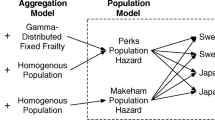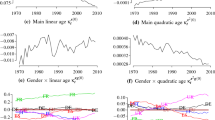Abstract
Reliable subnational mortality estimates are essential in the study of health inequalities within a country. One of the difficulties in producing such estimates is the presence of small populations among which the stochastic variation in death counts is relatively high, and thus the underlying mortality levels are unclear. We present a Bayesian hierarchical model to estimate mortality at the subnational level. The model builds on characteristic age patterns in mortality curves, which are constructed using principal components from a set of reference mortality curves. Information on mortality rates are pooled across geographic space and are smoothed over time. Testing of the model shows reasonable estimates and uncertainty levels when it is applied both to simulated data that mimic U.S. counties and to real data for French départements. The model estimates have direct applications to the study of subregional health patterns and disparities.










Similar content being viewed by others
Notes
Throughout this article, we refer to the Y px as principal components for simplicity, even though technically Y px is the pth vector of principal component loadings.
Data on age-specific mortality rates are available through the Centers for Disease Control and Prevention (CDC) Wide-ranging Online Data for Epidemiologic Research (WONDER) tool (https://wonder.cdc.gov/).
Personal communication to Magali Barbieri by the Division des statistiques régionales, locales et urbaines, INSEE (May 28, 2013). We chose to use French départements data because at the time of writing, data for all U.S. counties were not readily available.
References
Alkema, L., & New, J. R. (2014). Global estimation of child mortality using a Bayesian B-spline bias-reduction method. Annals of Applied Statistics, 8, 2122–2149.
Alkema, L., Raftery, A. E., Gerland, P., Clark, S. J., Pelletier, F., Buettner, T., & Heilig, G. K. (2012). Probabilistic projections of the total fertility rate for all countries. Demography, 48, 815–839.
Barbieri, M. (2013). Mortality in France by département. Population, 68, 375–417.
Bijak, J. (2008). Bayesian methods in international migration forecasting. In J. Raymer & F. Willekens (Eds.), International migration in Europe: Data, models and estimates (pp. 253–281). Chichester, UK: John Wiley & Sons.
Bravo, J. M., & Malta, J. (2010). Estimating life expectancy in small population areas. In EROSTAT–European Commission (Ed.), Work session on demographic projections: EUROSTAT methodologies and working papers (2010 ed., pp. 113–126). Luxembourg City, Luxembourg: Publications Office of the European Union.
Chetty, R., Stepner, M., Abraham, S., Lin, S., Scuderi, B., Turner, N., . . . Cutler, D. (2016). The association between income and life expectancy in the United States, 2001–2014. JAMA, 315, 1750–1766.
Congdon, P. (2009). Life expectancies for small areas: A Bayesian random effects methodology. International Statistical Review, 77, 222–240.
Congdon, P. (2014). Estimating life expectancies for US small areas: A regression framework. Journal of Geographical Systems, 16, 1–18.
Currie, J., & Schwandt, H. (2016). Mortality inequality: The good news from a county-level approach. Journal of Economic Perspectives, 30(2), 29–52.
Dwyer-Lindgren, L., Bertozzi-Villa, A., Stubbs, R. W., Morozoff, C., Kutz, M. J., Huynh, C., . . . Flaxman, A. D. (2016). US county-level trends in mortality rates for major causes of death, 1980–2014. JAMA, 316, 2385–2401.
Ezzati, M., Friedman, A. B., Kulkarni, S. C., & Murray, C. J. L. (2008). The reversal of fortunes: Trends in county mortality and cross-county mortality disparities in the United States. PLoS Medicine, 5, e66. doi:10.1371/journal.pmed.0050066
Gelman, A., & Rubin, D. (1992). Inference from iterative simulation using multiple sequences. Statistical Science, 7, 457–511.
Girosi, F., & King, G. (2008). Demographic forecasting. Princeton, NJ: Princeton University Press.
Jarner, S. F., & Kryger, E. M. (2011). Modelling adult mortality in small populations: The SAINT model. ASTIN Bulletin, 41, 377–418.
Kindig, D. A., & Cheng, E. R. (2013). Even as mortality fell in most US counties, female mortality nonetheless rose in 42.8 percent of counties from 1992 to 2006. Health Affairs, 32, 451–458.
King, G., & Soneji, S. (2011). The future of death in America, Demographic Research, 25(article 1), 1–38. doi:10.4054/DemRes.2011.25.1
Kulkarni, S. C., Levin-Rector, A., Ezzati, M., & Murray, C. J. (2011). Falling behind: Life expectancy in US counties from 2000 to 2007 in an international context. Population Health Metrics, 9, 16. doi:10.1186/1478-7954-9-16
Lee, R. D., & Carter, L. R. (1992). Modeling and forecasting U.S. mortality. Journal of the American Statistical Association, 87, 659–675.
Macintyre, S., Ellaway, A., & Cummins, S. (2002). Place effects on health: How can we conceptualise, operationalise and measure them? Social Science & Medicine, 55, 125–139.
Plummer, M. (2003, March). JAGS: A program for analysis of Bayesian graphical models using Gibbs sampling. Paper presented at the Third International Workshop on Distributed Statistical Computing, Vienna, Austria. Retrieved from https://www.r-project.org/conferences/DSC-2003/Proceedings/
Raftery, A. E., Chunn, J. L., Gerland, P., & Sevcikova, H. (2013). Bayesian probabilistic projections of life expectancy for all countries. Demography, 50, 777–801.
Raftery, A. E., Li, N., Sevcikova, H., Gerland, P., & Heilig, G. K. (2012). Bayesian probabilistic population projections for all countries. Proceedings of the National Academy of Sciences of the USA, 109, 13915–13921.
Schmertmann, C., Zagheni, E., Goldstein, J., & Myrskyla, M. (2014). Bayesian forecasting of cohort fertility. Journal of the American Statistical Association, 109, 500–513.
Sharrow, D. J., Clark, S. J., Collinson, M. A., Kahn, K., & Tillman, S. M. (2013). The age pattern of increases in mortality affected by HIV: Bayesian fit of the Heligman-Pollard Model to data from the Agincourt HDSS field site in rural northeast South Africa. Demographic Research, 29(article 39), 1039–1096. doi:10.4054/DemRes.2013.29.39
Srebotnjak, T., Mokdad, A. H., & Murray, C. J. L. (2010). A novel framework for validating and applying standardized small area measurement strategies. Population Health Metrics, 8, 26. doi:10.1186/1478-7954-8-26
U.S. Census Bureau. (2015). County population totals tables (Vintage 2014). Retrieved from https://www.census.gov/programs-surveys/popest/data/tables.2014.html
Acknowledgments
This study was made possible by an award from the Center on the Economics and Demography of Aging (National Institute on Aging grant P30-AG012839) at the University of California, Berkeley. However, any opinions, findings, and conclusions or recommendations expressed in this material are those of the authors alone and do not necessarily represent the official views of the National Institute on Aging. The authors would like to thank two anonymous reviewers for helpful comments on an earlier version of this manuscript.
Author information
Authors and Affiliations
Corresponding author
Rights and permissions
About this article
Cite this article
Alexander, M., Zagheni, E. & Barbieri, M. A Flexible Bayesian Model for Estimating Subnational Mortality. Demography 54, 2025–2041 (2017). https://doi.org/10.1007/s13524-017-0618-7
Published:
Issue Date:
DOI: https://doi.org/10.1007/s13524-017-0618-7




